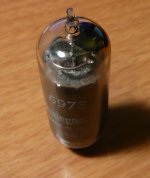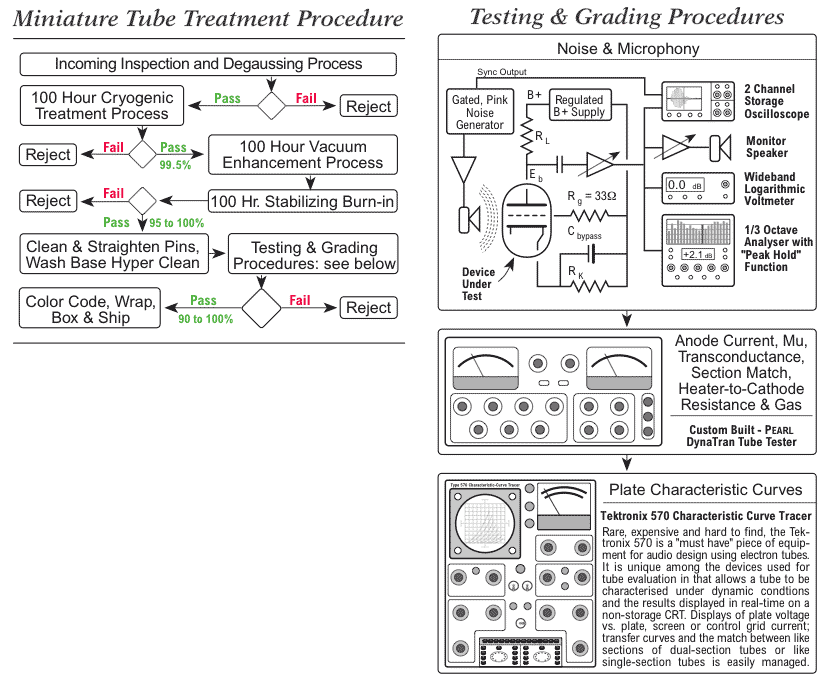Serge66 said:
One of these days, they will turn around and start heat treating the VTs. You watch.
You can already do that yourself, if you have an oven. It may even help the getter along a bit in an old valve, as SY noted previously. No company is going to be very successful charging you $200 to stick your 12au7 in their oven for you though, so perhaps it's no surprise no one pushes it much.
edit: spelling
Boris_The_Blade said:T'would be neat to be able to refresh the getter at home.
But you have an oven, don't you?
EC8010 said:
But you have an oven, don't you?
Well, according to http://www.thevalvepage.com/valvetek/getter/getter.htm, no oven of mine will ever suffice to flash getters. Wouldn't it be dangerous (or risky to the vacuum) to have the glass at flashing temperature if an oven-heated method were used?
SY said:The getter has already been flashed. All you're trying to do is get those little molecules in the tube to zip around fast enough to get eaten by the getter more quickly.
For most tubes yes. I understand that the baking you're referring to is just to release gasses from the materials inside the tube to be collected. There are a few I have that I wished they were reflashed, however. Like this one (see attached) and a few tung-sol 5881s I've collected that look like they should have been cooked little longer. It's hard to say if there was insufficient material on the getter ring or just didn't boil it off fully, though. Also, it could have just all collected in that little spot, but the spot is a bit see-though, so I would assume there 'should be more where that came from.'
I would probably never build anything like that though, too much expense and work for too little payoff. Easier to just buy another tube, but I wondered if anyone has done it.
Attachments
Could there be a chance for some sort of reaction to the emitter layer?, say for example thorium, tungsten (not sure whats in a 12AU7) that causes the layer to smooth out, i.e take the miniscule bumps out out the emitting material causing the electron flow to be more even.Just couple of words about cryo treatment.
Cryo treatment is also called negative quenching and it has substantial influence of increasing properties of steels. There is quite a bit of scientific studies and proof for this. The improvement is in strength, fatigue life and electrical conductivity due to change in crystal structure.
There is no proof that the same mechanisms work in aluminium and copper. I personally did some test with aluminium parts and there was no change what so ever. The cryo treatment I am talking about is cooling down to 10K (-263C) and repeating that for 5 or 6 times.
Whether it does anything to valves I do not know.
This could cause greater linearity and increased trans-conductance owing to the electrical surface density being simply flatter. A great many more electrons can flow from an even surface than just a few at a time boiled off from a pointed area (microns big). We could all get into an argument about how electrical surface density is greater at pointed surfaces, and how an inrush of electrons at that point could affect the operation of the tube but I am just pointing out that science for temperatures that low can sometimes be counter-intuitive... Just look how liquid helium, when chilled to near absolute zero ( classified as a super fluid ) can permeate glass like water through a soggy brown paper bag.
Having said all of this, I would never make a decision without proper testing, and if testing is only "what you hear" then that's not good enough. If the test equipment can tell us every step of the way if a tube has passed or failed the process then you can use the same equipment to show the differences in the tube before and after treatment. Whatever these 'differences' may be......
I believe the purpose of heating the tube in an oven is not to release gasses in the internal material, but rather to elevate the temp of the getter flash to increase its reactivity to recombine with gasses already present inside the tube. It also increases the energy level of the gasses which increases their probability of striking the getter material and combining with it.
Could there be a chance for some sort of reaction to the emitter layer?, say for example thorium, tungsten (not sure whats in a 12AU7) that causes the layer to smooth out, i.e take the miniscule bumps out out the emitting material causing the electron flow to be more even.
Only if magic is involved. Not that electron flow would be more even if that happened, but I'm unaware of any process whereby metal surfaces are "smoothed" by cooling.
Yes, I could improve a box of valves by just sitting and watching them for 100 hours, provided I could also do all the pre- and post- selection tests.
I have a cryo rig at home I use.
First, I purchase about a gross of those Chinese 12ax7's. They're only $.18 ea. if you speak Mandarin. Xie, xie!
Then I put each one very carefully in an ice cube tray and use Mountain Myst Spring water to cover them. Freeze for 3 hours or until the impatient guests arrive.
Then I place them in a large bowl and cover them with a pint of ginger ale and 3 fifths of Cosmonaut Vodka.
When scooped, if your cube melts down and has one of the tubes, IT'S YOURS to KEEP as a party gift.
Last edited:
When looking at the cryo diagram -- what strikes me is all the pass/fail boxes..
snip...
image removed, see post 110.
/snip...
Even if the cryo treatment has no influence on the tubes, all the selection has!
I wonder about that "Vacuum Enhancement Procedure"...
Bake them in an oven?
Perhaps the emitter layer contracts at a different ratio to the cathode itself. If the cathode contracts more than the oxide layer then there could be some shifting of elements in the tube. Show a TV to someone 150 years ago and they would think it is magic....or the devils work.Only if magic is involved. Not that electron flow would be more even if that happened, but I'm unaware of any process whereby metal surfaces are "smoothed" by cooling.
If that's true, it will flake off and microcrack. Unless it's tightly bound, in which case it will contract, then expand again when the tube is brought back to room temp. I can't conceive of any mechanism that will cause it to smooth out, nor is there any evidence at all that a smoother surface would reduce noise. Do painted bridges in Alaska get smoother over the winter?
Invocation of magic, mysterious forces with no backup data isn't terribly convincing.
Invocation of magic, mysterious forces with no backup data isn't terribly convincing.
True that, however tap a ferrite bar the right way and it will align magnetically, not so obvious from just looking at it. And who knows the bridges in Calgary sure got smoother in the winter when I was there, although this was probably due to black iceIf that's true, it will flake off and microcrack. Unless it's tightly bound, in which case it will contract, then expand again when the tube is brought back to room temp. I can't conceive of any mechanism that will cause it to smooth out, nor is there any evidence at all that a smoother surface would reduce noise. Do painted bridges in Alaska get smoother over the winter?
Invocation of magic, mysterious forces with no backup data isn't terribly convincing.
but I'm unaware of any process whereby metal surfaces are "smoothed" by cooling.
I'd want to Google Scholar that statement -- I think you can polish thin metal films cryogenically.
- Status
- This old topic is closed. If you want to reopen this topic, contact a moderator using the "Report Post" button.
- Home
- Amplifiers
- Tubes / Valves
- Cryotubes? Cryogenically Frozen valves

